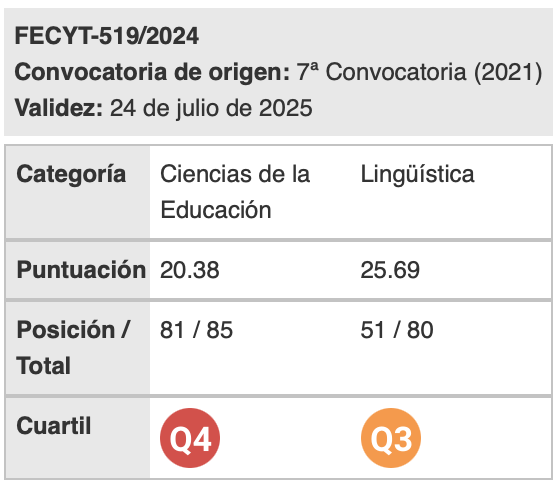Vocabulario químico en los manuscritos médicos del inglés medio
Palabras clave:
manuscritos médicos, inglés medio, química, términos simples, compuestos nominalesResumen
Hunt (1990: 19) afirmó que en las recetas médicas los elementos químicos y minerales son inusuales. Aunque el número de elementos no puede compararse con los 1.800 nombres de plantas autentificados en inglés medio (Sauer 2011: 57), nuestra investigación revela que en manuscritos médicos escritos en inglés medio hay un abundante número de términos químicos que incluyen sustancias como metales y sus compuestos, extractos de plantas e ingredientes médicos sintéticos. Por ello, es necesario llevar a cabo un exhaustivo análisis lingüístico en manuscritos médicos medievales que contengan estas sustancias. Para llevar a cabo el estudio del léxico de ingredientes químicos, hemos recopilado un corpus formado por manuscritos de diferentes bibliotecas británicas de aproximadamente 215.000 palabras. Nuestro objetivo es llevar a cabo un análisis lingüístico del léxico de este campo en inglés medio, basado en los datos extraídos de fuentes auténticas, la mayoría de las cuales no han sido nunca publicadas. Hemos examinado la procedencia de los nombres según su etimología para comprobar cuándo se trataba de préstamos o de palabras nativas en el caso de los términos simples. También hemos analizado la estructura y constituyentes de los grupos nominales según las taxonomías de Bauer (1983 and 2017) y Norri (1991).
Descargas
Citas
Alonso-Almeida, F. (2000). Edition and Study of a Late Medieval English Medical Receptarium: GUL MS Hunter 185 (T. 8.17). Unpublished Doctoral Dissertation. University of Las Palmas de Gran Canaria.
Alonso-Almeida, F. (2014). A Middle English Medical Remedy Book. Heidelberg: Winter.
Bauer, L. (1983). Word Formation. Cambridge: Cambridge University Press.
Bauer, L. (2017). Compounds and Compounding. Cambridge: Cambridge University Press.
Carrillo-Linares, M.J. (1997). Edición de una Versión en Inglés Medio del Antidotarium Nicholai. Unpublished Doctoral Dissertation: University of Sevilla.
De la Cruz-Cabanillas, I. & Diego-Rodríguez, I. (2018). Therapeutic Plant Names: Neologising, Borrowing and Compounding in a Late Middle English Medical Corpus. Presented at the 20th International Conference of English Historical Linguistics (ICEHL). University of Edinburgh, Scotland.
Getz, F.M. (1991). Healing and Society in Medieval England: A Middle English Translation of the Pharmaceutical Writings of Gilbertus Anglicus. Madison: University of Winsconsin Press.
Grund, P.J. (2013). The ‘Forgotten’ Language of Middle English Alchemy: Exploring Alchemical Lexis in the MED and the OED. Review of English Studies, 65(271), 575–95.
Hunt, T. (1989). Plant Names of Medieval England. Cambridge: D. S. Brewer.
Hunt, T. (1990). Popular Medicine in Thirteenth Century England. Cambridge: D. S. Brewer.
Kastovsky, D. (1992). Semantics and Vocabulary. In R. Hogg (Ed.), The Cambridge History of the English Language. Vol. 1 The Beginnings to 1066 (pp. 290–408). Cambridge: Cambridge University Press.
Krische, U. (2010). The Old English Complex Plant Names: A Linguistic Survey and a Catalogue. Frankfurt am Main: Peter Lang.
Marchand, H. (1969). The Categories and Types of Present-Day English Word-Formation. A Synchronic and Diachronic Approach, 2nd ed. Munich: C. H. Beck.
Middle English Dictionary. Online edition: <https://quod.lib.umich.edu/m/med/> [20/12/2020].
Miranda-García, A. and Calle-Martín, J. (2012). The Middle English Version of De Viribus Herbarum (GUL MS Hunter 497, ff. 1r-92r). Edition and Philological Study. Frankfurt am Main: Peter Lang.
Norri, J. (1991). Notes on the Origin and Meaning of Chemical Terms in Middle English Manuscripts. Neophilologische Mitteilungen, 92, 215–36.
Norri, J. (2016). Dictionary of Medical Vocabulary in English, 1375–1550, Vols. 1, 2. London: Routledge.
Oxford English Dictionary. Online edition: [20/12/2020].
Pahta, P. (2004). Code-Switching in Medieval Medical Writing. In I. Taavitsainen & P. Pahta (Eds.), Medical and Scientific Writing in Late Medieval English (pp. 73–99). Cambridge: Cambridge University Press.
Pahta, P. & Taavitsainen, I. (2004). Vernacularisation of Scientific and Medical Writings in its Sociohistorical Context. In I. Taavitsainen & P. Pahta (Eds.), Medical and Scientific Writing in Late Medieval English (pp. 1–22). Cambridge: Cambridge University Press.
Sauer, H. (1995). On the Analysis of Old and Middle English Plant Names. In B. Santano-Moreno (Ed.), Proceedings of the 10th International Conference of the Spanish Society of Medieval Language and Literature (pp. 299–325). Cáceres: Universidad de Extremadura
Sauer, H. (2011). Patterns of Loan-Influence on the Medieval English Plant Names, with Special Reference to the Influence of Greek. In J. Fisiak, & M. Bator (Eds.), Foreign Influence on Medieval English (pp. 55–76). Frankfurt am Main: Peter Lang.
Schendler, H. & Wright, L. (2011). Code-Switching in Early English: Historical Background and Methodological and Theoretical Issues. In H. Schendler & L. Wright (Eds.), Code-Switching in Early English (pp. 15-46). Berlin: De Gruyter.
Skaffari, J. (2016). Code-Switching and Vernacular Support: An Early Middle English Case Study. Multilingua, 35(2), 203-226.
Sakaffari, J. & Mäkilähde. A. (2014). Code-Switching in Historical Materials: Research at the Limits of Contact Linguistics. In R. Nicolaï (Ed.), Questioning Language Contact: Limits of Contact (pp. 252-279). Leiden: Brill.
Descargas
Publicado
Cómo citar
Número
Sección
Licencia
Aquellos autores/as que tengan publicaciones con esta revista, aceptan los términos siguientes:
- Los autores/as conservarán sus derechos de autor y garantizarán a la revista el derecho de primera publicación de su obra, el cuál estará simultáneamente sujeto a la Licencia de reconocimiento de Creative Commons que permite a terceros compartir la obra siempre que se indique su autor y su primera publicación esta revista.
- Los autores/as podrán adoptar otros acuerdos de licencia no exclusiva de distribución de la versión de la obra publicada (p. ej.: depositarla en un archivo telemático institucional o publicarla en un volumen monográfico) siempre que se indique la publicación inicial en esta revista.
- Se permite y recomienda a los autores/as difundir su obra a través de Internet (p. ej.: en archivos telemáticos institucionales o en su página web) antes y durante el proceso de envío, lo cual puede producir intercambios interesantes y aumentar las citas de la obra publicada. (Véase El efecto del acceso abierto).

Revista de Lenguas para fines específicos is licensed under a Creative Commons Reconocimiento-NoComercial-SinObraDerivada 4.0 Internacional License.























